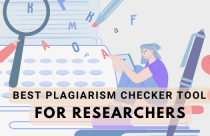How to Scan Through Millions of Articles and Still Cut Down on Your Reading Time — Why not do it with an AI-based article summarizer?

Researcher 1: “It’s flooding articles every time I switch on my laptop!”
Researcher 2: “Why don’t you categorize your downloaded data?”
Researcher 1: “I have. But the amount of data is enormous. Where should I even start from?”
This conversation is not new to researchers who have begun collating scholarly research data. The information overload, although a boon in many ways, is also making it difficult to identify relevant data for your research paper. Despite having found all the necessary information, you are left perplexed as to which research paper should you prioritize to read. You can’t read all those 124 journal articles, 27 book chapters, 45 preprints, and 8 dissertation chapters that you downloaded. It would take forever! It will be much simpler if all these research papers are summarized section-wise. Let’s read through to find out how researchers can know which of the resources are relevant to their research topic and how they can optimize their time using a research article section-wise summarizer.
The Difficulty in Manually Collating and Summarizing the Enormous Downloaded Research Data
In the literature reviewing process, it is imperative to tame large amounts of downloaded data from multiple sources and derive the greatest value with only relevant data. The collation and management of massive amounts of research information have to be a methodical approach. It helps in deriving insights and prioritizing papers to read for literature review. However, information overload has confounded researchers in their attempts to manage and analyze research data, let alone summarize the articles.
The secret to accurate research paper section-wise summarizing is capturing the key points. Summarizing each article manually is an arduous process. The first step to research paper summarizing is reading the papers thoroughly. However, how could you read all the research papers from start to end, pay attention to annotations, subheadings, and even references? Furthermore, key points aren’t always obvious. Hence, reading through each section separately to avoid missing key points is an overwhelming process. These challenges of section-wise summarizing of research papers manually continue. It requires a structured, well-planned collation, and summarizing of data based on their relevance to prioritize papers to read.
Apart from information overload, the problems that hinder a systematic approach to literature review are:
- Selection bias: Resources should not be considered relevant only based on keywords.
- Lack of comprehensiveness: This occurs due to ambiguity in understanding the research question and searching for information with incorrect or irrelevant terms.
- Failure to test evidence of publication: This can result in misleading your conclusions.
- Lack of transparency/replicability: Review replication is a central tenet of the scientific method. If the review methods are not transparent and cannot be replicated, they cannot be considered reliable.
How Can Researchers Decide and Prioritize the Literature to Read?
Reading the title cannot alone be a deciding factor for reading a paper. Generally, researchers will read the abstract, results, and conclusion to decide if the paper is worth further reading and relevant to their research topic. However, with data deluge, following the same practice in today’s time is both a time-consuming and strenuous effort.
Finding the right information from numerous downloaded resources continues to be a task. With being a time and effort-draining process, one can’t derive insights merely based on the abstract and conclusion of a paper. It is possible that a few key aspects, which can be relevant to your research topic are missed out in the abstract or conclusion. Hence, researchers could take the help of AI and explore new technologies to prioritize papers to read. A potential solution to this is if every section of a research paper is summarized emphasizing its key aspects. This will allow researchers to only read what’s relevant, save time, and most importantly, cite the right resources.
What Is a Research Article Section-wise Summarizer?
Generally, most (if not all) research papers are divided into 6 major sections, viz., abstract, introduction, methods and methodology, results, discussions, and conclusion. Each of these sections includes a piece of key information that is important to conduct a literature review. However, the surplus research data and the time constraint hinders the process of deciding which papers to read first that deem suitable for their research topic.
Whether or not an article must be read can be decided if the article’s key aspects and findings are auto-generated in section-wise summaries. This will ensure prioritizing of papers to read without the fear of missing out on important relevant information for literature review.
How Section-wise Article Summaries and Key Insights Speed up Critical Reading?
Literature search and review is a systematic approach to authentic and reliable research data. Critical reading plays an imperative role in examining and analyzing discovered resources. Reading each downloaded paper is a process that demands time and undivided attention. Moreover, it is bothersome to find that the paper you read is not even remotely related to your research topic.
In this case, rather than spending a lot of time in critical reading of each downloaded resource, researchers could resort to an AI-based tool that captures crucial aspects of research papers. Key assumptions, the novelty in findings, limitations of the research, etc. cannot be found only by reading the abstract and conclusion. Hence, an article summarizer, which does not only abridges a research paper but also creates section-wise summaries maintaining all key aspects of the paper is a solution to this.
Section-wise summary of an article forms the gist of each section of the paper. It helps users to analyze the data and correlate it to their research topic helping them to speed up their decision-making and paper prioritization process. Along with the section-wise summary feature, the key insights feature of the knowledge manager helps the user in capturing specific aspects of the whole paper without missing out on any section. This helps researchers in prioritizing papers to read as well as giving them a quick recap of the read papers.
Where to Find These Unique Features? Knowledge Manager- Surpassing the Limits of Reference Managers!
As science advances, so will the amount of literature. Hence, organizing this enormous amount of research data is humanly impossible; it requires an efficient and reliable AI-based tool such as the knowledge manager that not only saves and organizes downloaded resources but also goes beyond the conventional reference managers and helps researchers in prioritizing papers for critical reading.
Knowledge Manager will help researchers in the following ways:
- Quick comprehension of downloaded resources
- Deciding which papers to prioritize for critical reading
- Citing relevant papers
- Developing section-wise summaries without missing out on important details
- Help capture crucial aspects of papers
- Key insights for each paper for a quick recap
Are you still struggling to collate your research data and manage it? Or have no clue as to which literature to prioritize to read? Go beyond reference management and explore the Knowledge Manager to ease critical reading for literature review.










A good summariser but premium is too high.